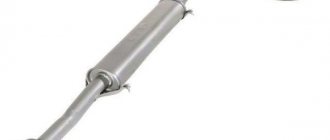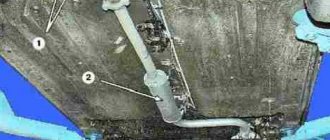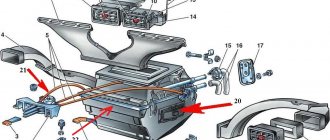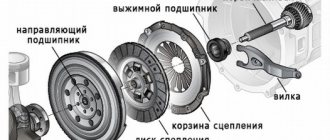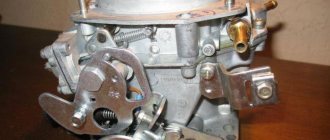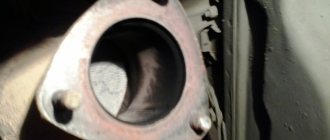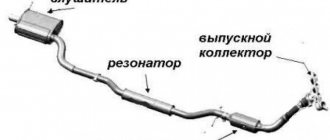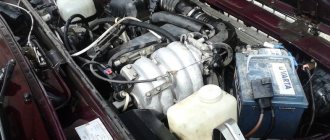Purpose and design of the muffler for VAZ 2104–2107 cars
Exhaust gases escape from the engine cylinders under high pressure and with loud noise. The muffler receives and slows down gases, converts their kinetic energy into thermal energy, smoothes out pulsations and muffles the sound, then releases the weakened exhaust into the atmosphere.
Thus, among the main functions of the muffler:
- reduction of engine noise;
- conversion of exhaust gas energy;
- safe release of gases into the atmosphere.
In everyday life, a muffler is called an exhaust tract or exhaust system. In fact, it is only one, albeit the most important, element of the fuel system. For VAZ cars with a classic layout, it consists of a reception pipe connected to the engine exhaust manifold, an additional (resonator) and a main muffler.
For VAZ cars with a classic layout, the exhaust gas system consists of a reception pipe connected to the engine exhaust manifold, an additional and main muffler
All of the above is located under the bottom of the car. The system elements - pipe, resonator and muffler - are attached to each other with clamps. The exhaust pipe is rigidly screwed to the manifold and the gearbox cover, the main muffler body is suspended from the body by rubber straps, and the exhaust pipe is suspended by a rubber cushion.
At the Politburo, the Minister of Automotive Industry Alexander Mikhailovich Tarasov made a report in which he spoke about the state of affairs in the automobile industry and spoke about the need to build a new plant using foreign experience, and Dmitry Fedorovich Ustinov, the former head of the Ministry of Defense, who oversaw issues of the military-industrial complex, objected, that having such a “defense industry”, it costs nothing to build a new plant on our own. And then Kosygin proposed building two factories - one using Soviet “patterns”, and the second - with foreigners. The idea was accepted, and as a result, two with a capacity of 220,000 cars per year and a VAZ with an annual capacity of 660,000 cars appeared.
Innokenty Kishkurno
Wheels
What is a muffler for?
Naturally, making the car sound quieter. Physically, the combustion of a mixture of air and gasoline produces vibrations of different frequencies, from low to high. The sound from the exhaust manifold carries all the energy of sound vibrations into the muffler, which is equipped with several special chambers. Like any wave, the sound from a motor has energy, or amplitude. The higher it is, the noisier the motor is. When it enters the chambers, the sound “gets entangled” and gives up its energy, turning into heat. This is why the muffler parts are so hot, although they are far from the engine, and the exhaust itself from the exhaust pipe is slightly warm. So, the first function is to make the engine quieter.
The second important function is the removal of combustion products, otherwise the mixture will not ignite in the zone of high carbon dioxide content.
The third function is keeping the cylinders clean and ventilating them.
It must be remembered that the exhaust system takes on very large thermal and chemical loads, and parts can “burn out”, since toxic exhaust gases, mixing with condensate, form complex acids, which are very aggressive at high temperatures.
On the outside, moisture, impacts from gravel, salt in winter and other causes also contribute to wear. Those who use their car in winter need to replace the muffler much more often.
What is the design of the VAZ 2107 muffler
The muffler is only part of the exhaust system. Its structure is as follows:
- Exhaust gases penetrate through the exhaust manifold into the so-called “pants” 12, which are called the exhaust pipe. The “pants” are separated from the exhaust manifold by a special gasket 11, which is designed to seal their fastening.
- The pipe is attached to the gearbox using bracket 15.
- Then there is a series of additional resonators, or mufflers, front and rear, which are attached using clamps 7 to the “pants” and 6 to the main muffler. These mufflers cut off certain sounds from high engine frequencies. Together they are called "additional muffler" 13.
- The main muffler (main) 3 is movably fixed to the bottom so that its frequency is not transmitted to the body. This mount can additionally dampen vibrations due to the “sway” of the muffler itself. It is produced using parts 1-4.
- Next comes the exhaust pipe.
Here it should be said that by the color of the exhaust and the condition of the pipe, one can draw certain conclusions about the operation of the engine, just as doctors draw conclusions about the work of the intestines by analyzing stool. For example, if you run your finger inside the pipe and a greasy, oily residue remains, then the oil scraper rings have become unusable and the engine “eats” oil, which is indicated by the black color of the exhaust. Normally, the inside surface of the exhaust pipe is dry.
The exhaust system assembly is shown below:
The main muffler contains numerous chambers consisting of perforated pipes.
The figure also shows the main muffler mounting and extension pad
An important feature of the VAZ 2107 muffler is its complete “interchangeability” with the rest of the classics. If you purchase parts from a VAZ 2101, or any other modification, you can’t go wrong
If your muffler needs replacement, it is better to do this at a service center, and purchase spare parts there so that there is a guarantee for the installation. Simply replacing a muffler is a messy business, especially if you have to start from the “pants.” It is possible that you will need to cut off the stuck joints with a grinder.
A few words about sports modifications of the VAZ 2107 muffler
A conventional muffler is indirect, this increases the pressure in the exhaust manifold and can reduce engine power. At that time, a direct-flow, sports muffler filled with ceramic fiber is able to increase engine power by faster cleaning of the cylinders from exhaust gases. It should be said that the sports muffler of the direct-flow system will never “scream”, and the engine operating volume will be quite acceptable.
Replacement and repair of muffler for VAZ 2104–2107 cars
To replace the muffler you will need:
- inspection hole or lift;
- screwdriver;
- a set of car keys;
- hammer.
Removing and installing the muffler
To dismantle the “glushak”, repair it, and then return it to its place, follow this sequence of actions:
- Drive the car into the inspection hole. Stop the engine and turn off the ignition. Wait until the exhaust manifold cools down.
- Unbend the hooks of the rubber suspension straps of the muffler.
Using a screwdriver, straighten the hooks of the rubber straps on which the muffler is suspended
Unscrew the exhaust pipe fastening to the rubber cushion with a wrench
Loosen the clamp between the pipes of the main and additional muffler
Carefully knock the resonator out of the mount by hitting it with a hammer through a wooden spacer
Unscrew the exhaust pipe from the gearbox bracket
Carefully bend the stoppers and unscrew the exhaust pipe from the manifold
Install the new muffler in the opposite order of removal. However, do not use a used gasket. Before assembly, treat the pipes at the places where they are connected with clamps with graphite lubricant.
Video: replacing a VAZ 2107 muffler in a garage
In 1979, at VAZ, a car was built especially for “dear Leonid Ilyich,” which received the common name “half past six.” This happened after the presentation of the VAZ-2105 and 2107 models to the country's leadership, the serial production of which was still quite far away, and Brezhnev wished to give such a car to one of his family members. The result was a unique car, the body and interior of which was a hybrid of a “six” and a “seven” - hence the name.
Innokenty Kishkurno
How to repair a muffler with your own hands
Before you begin repairing the muffler, you need to evaluate the feasibility of these actions. Not every car owner has the skills to work with a welding machine. In addition, the muffler cannot always be properly repaired - in cases of severe burnout, it is best to immediately replace it with a new one.
Reasons for failure
Most often, mufflers on the VAZ 2106/2107 lose their functionality for the following reasons:
mechanical damage while driving on uneven roads, impacts;
rapid changes in temperature conditions, especially in winter, when it is cold outside, and inside the case there are very high temperatures due to exhaust;
impurities in gasoline that come out along with exhaust gases and affect the condition of the metal surfaces of the muffler.
It is unsafe to operate a car with such damage to the muffler.
However, how urgently do you need to repair the muffler if you suddenly notice some damage to its body or black exhaust from the pipe? What are the dangers of operating a Zhiguli with a burnt out or deformed muffler?
Firstly, if there are holes in the body of any element, then the generated gases will enter the cabin. The main danger is that the exhaust is colorless and odorless and cannot be felt. In this case, the driver begins to experience headaches, nausea and dizziness. If you stay inside a car with the engine running for a long time, you can lose consciousness and even die.
Secondly, if the exhaust system does not work properly, engine power is reduced. This is especially noticeable when accelerating, starting from a standstill, or overtaking.
Thirdly, if the plug is faulty, the engine begins to consume a lot of gasoline. The carelessness of the car owner will lead to the fact that the muffler will work worse and worse, and the displacement per 100 km will increase.
How to weld a muffler
Most often, the muffler loses its tightness and therefore cannot work normally. In this case, holes can appear both on the pipes themselves and on the welds.
It is recommended to clean the weld seam and paint the work area with heat-resistant paint
Using a welding machine and metal patches can be considered the most reliable way to repair mufflers.
In order to weld a “muffler”, you need to prepare electrodes of a suitable size (it all depends on how large the hole is burned in the muffler) and a sheet of metal of the required size. After which it is recommended to carry out welding as far as possible from the edge of the holes, since the thinned edges of the metal can quickly collapse:
It is recommended to apply welds carefully so as not to burn through the muffler body
How to change the gasket
There is a reinforced gasket between the main muffler and the resonator part. Its purpose is to prevent the resonator from heating, so it is made of heat-resistant metal.
After dismantling the muffler, it is recommended to change the gasket. This does not take much time, since the element is inserted into the muffler pipe and clamped between its parts.
How to replace hanging rubber bands
This is perhaps the simplest procedure in repairing Zhiguli mufflers. The rear part of the pipe is attached to the body with three hanging rubber bands. During the ride, some of them may get lost or seriously deformed.
To change these rubber bands, you just need to drive the car into an inspection hole or overpass, remove the old products and install new ones in their place. Some car owners change suspension rubber bands without an overpass, simply crawling under the body from the rear left side.
Video: changing the resonator and muffler on a VAZ 2106/2107 car
The muffler in classic VAZ cars cannot, of course, be called a durable element.
However, it is up to the owner to carry out the necessary repairs in a timely manner or change the plug if necessary. Moreover, the procedure is simplified as much as possible by the design of the VAZ 2106/2107 themselves. Therefore, any work on the muffler can be done with your own hands in a garage. Source
How are knocking and muffler position related?
If the muffler suddenly starts knocking on some parts of the car, find the source of the extraneous sounds. Usually the reason lies in stretched rubber fasteners. After replacing them, the knocking will stop.
Sometimes a knock appears after work related to removing the muffler. In this case, extraneous sounds are a consequence of installation errors. Round pipes at the joints with clamps can be slightly rotated relative to the correct position: more or less than required, pushed into each other.
To eliminate knocking, restore the optimal position of the exhaust system elements.
Sagging mufflers can be “treated” using similar methods—by replacing rubber bands and correcting the position of joints.
Video: repairing a sagging VAZ 2106 muffler
The nuances of muffler repair
The muffler of “classic” VAZ cars, according to the manufacturer’s recommendations, cannot be repaired. If a malfunction occurs in any element of the exhaust tract, the part must be replaced with a new one.
In fact, motorists often prefer to repair holes burned in the muffler - the most common defect - by welding.
The occurrence of “fistulas” is indicated by a change in the sound of the engine and the appearance of smoke from under the car. To troubleshoot, place the machine on a platform and inspect the elements of the exhaust system.
If the cause is a burnt gasket, remove the muffler and replace it. When you have an assistant, you can do without removing all elements of the system. Proceed in the following order:
- Unscrew the pipe fastening to the gearbox.
- Unscrew the nuts securing the exhaust pipe to the manifold.
- Together with an assistant, pull the “pants” off the pins while simultaneously rotating the bend of the resonator pipe.
- Replace the gasket, install the pipe in place, tighten the fasteners.
Replacing a burnt muffler gasket eliminates extraneous sounds from the engine
A welded muffler usually lasts less than a new one. But welding is also cheaper than buying. Usually, if it is necessary to repair a muffler by welding, they turn to professionals. If you have the equipment, you can do the work yourself. For this you will need:
- welding machine;
- blanks for patches made of sheet metal 1–2 mm thick;
- a piece of pipe of the same diameter as the failed one;
- grinder with cutting disc for metal;
- metal brush;
- sandpaper;
- heat-resistant paint for metal.
To repair the muffler, follow this sequence:
- Remove the muffler from the vehicle.
- Using an external inspection, determine the location of the malfunction and the extent of the damage.
- If there is a large hole in the muffler body, evaluate the condition of the internal parts. It is possible that repairing the external surface will not bring the desired restoration of the functions of the muffler without replacing the internals. In this case, it is advisable to contact professionals or simply replace the faulty part with a new one.
- Cut out the burnt area. From the blank, make a patch larger than the damage. Weld the patch over the hole with a continuous seam.
- If there is damage at the junction of the pipe and the muffler body, cut out the defective area, replace the damaged part of the pipe, and weld the repaired pipe to the muffler with a continuous seam.
- Clean the repaired muffler from dirt and rust, paint the part with two layers of heat-resistant paint.
Photo gallery: muffler welding
Video: repairing a VAZ muffler by welding
Replacing and repairing a muffler is a dirty and time-consuming job. But there is nothing complicated about it. You never know what you can do till you try.
Over time, the exhaust system of the VAZ 2107 fails and the owner has to go to a service station or change it himself. In the latter case, you will need a standard tool and an inspection hole. You may also need a grinder and WD-40.
What muffler can be installed on the “seven”
There are 4 options for replacement:
- Standard VAZ 2101-2107 muffler made of ordinary steel with anti-corrosion coating. The plus is the low price of the product, the minus is the unpredictable duration of work. When purchasing, it is quite difficult to evaluate the quality of the metal and workmanship, unless the welds are made completely carelessly.
- Factory section made of stainless steel. The option is not cheap, but durable. The main thing is not to buy a fake made from cheap Chinese metal.
- The so-called direct-flow sports muffler, manufactured in a factory.
- Weld the outlet element of the desired design yourself.
Standard mufflers are made of ordinary metal with an anti-corrosion coating
If you do not have welding skills, the fourth option is automatically eliminated. All that remains is to choose between stock and sports parts.
A straight-through muffler differs from a standard muffler in the following ways:
- shape - round, outlet of larger diameter;
- design - inside is a straight perforated pipe, lined with fireproof sound-absorbing material;
- the operating sound is low-frequency, louder.
The factory-made direct flow is painted on the outside with heat-resistant paint, the pipe outlet is equipped with a decorative nozzle
The forward flow resistance is significantly less than the factory model of the muffler. The design makes it possible to ventilate the cylinders more efficiently and increase engine power by up to 5 hp. With. A side effect is a higher noise level, which brings pleasure to fans of extreme driving.
The stock design muffles noise due to several internal partitions and additional perforated pipes, causing gases to change direction and be reflected repeatedly from obstacles. Hence the high resistance of the element and a small drop in power.
In a conventional element, sound and gases change the direction of movement several times; in a direct flow, they are dissipated through the perforation of the pipe
Tuning enthusiasts install forward flow in combination with other means - zero-resistance filters, turbines, and so on. Replacing a standard muffler with a direct-flow muffler without performing other measures will give one result - a loud rumble, you will not feel an increase in engine power.
It is not difficult for a car enthusiast who owns a welding machine to make a forward flow independently:
- Make a round tank from sheet metal (you will need rollers) or select a ready-made can from another car brand, for example, Tavria.
- Place a perforated pipe inside, having previously drilled many holes with a diameter of 5-6 mm.
It's easier to make slits in a pipe, but it's better to spend more time making the holes - Fill the cavity between the straight channel and the walls tightly with non-flammable basalt fiber.
- Weld the end walls and supply pipes. A curved element from an old muffler is perfect as an inlet pipe.
If desired, the direct flow can be made double - then the noise level will decrease - At the required points, attach 3 fasteners corresponding to the standard hangers.
You can refine the outlet pipe using a nickel-plated decorative nozzle. The choice of products in size and shape is extremely wide, the prices are quite affordable.
Video: making a direct flow with your own hands
Exhaust system design of VAZ 2107
Like most passenger cars, the VAZ 2107 has an exhaust system consisting of three main parts:
- a receiving pipe into which gases enter from the exhaust manifolds;
- VAZ 2107 resonator (additional muffler), where gases are directed from the exhaust pipe and where the exhaust sound is partially reduced;
- muffler, which absorbs most of the engine exhaust noise.
In addition to the above parts, the exhaust system includes:
- muffler mounting pad;
- pillow bolt;
- muffler suspension belt;
- clamp bolt and clamp securing the muffler to the resonator;
- clamp bolt and clamp securing the resonator to the exhaust pipe;
- clamp bolt and clamp securing the exhaust pipe to the body;
- nuts securing the exhaust pipe to the manifold;
- pad;
- locking plate;
Exhaust system functions and parts replacement intervals
Despite its apparent simplicity, the exhaust system performs several important functions:
- removal of fuel combustion products;
- reduction of noise level from the exhaust;
- maintaining air balance in intake and exhaust systems;
- ensuring ventilation and cleaning of cylinders;
- reduction of CO content (in the presence of a catalyst).
Exposure to high temperatures, moisture, fuel and oil combustion products leads to through corrosion of exhaust system parts. This is aggravated by the external influence of gravel, sand and salt solutions that are used to treat roads in winter. Therefore, parts of the system have to be changed. The frequency of replacement depends on the following factors:
- car use activity;
- frequency of machine operation in bad weather (rain, snow);
- fuel quality;
- quality of exhaust system parts.
Replacing the muffler VAZ 2107
The VAZ 2107 muffler (injector and carburetor) is connected to the resonator with a clamp, which is located in front of the rear axle. Before removing the clamp, it should be tapped with a hammer to make it easier to unscrew the threaded connection and uncouple the pipes. To change the muffler, you need to do the following:
- loosen the clamp bolt and remove (move) the clamp;
- pull the flared muffler pipe off the resonator (if that doesn’t work, knock it down with a hammer and chisel);
- remove the muffler from the cushion and mounting straps;
- install a new muffler on the VAZ 2107;
- tighten the clamp.
Replacing the VAZ 2107 resonator
The VAZ 2107 resonator does not have fastening parts to the car body, so it is necessary to hold it when replacing it. Otherwise the exhaust pipe will be bent.
The replacement work consists of the following steps:
- tap clamps and pipe connections with a hammer;
- loosen the bolts of the clamps and move the clamps fastening to the “pants” and the muffler;
- disconnect the resonator from the muffler by undocking the pipes;
- disconnect the resonator from the receiving pipe (“pants”);
- install the new resonator in the correct position;
- connect the parts and tighten the fastening clamps.
Note: the resonator tank must be parallel to the ground, otherwise the part will knock on the bottom of the car and cling to uneven road surfaces.
What is important to know about the resonator
Malfunctions of the exhaust system of the VAZ 2110
Structurally, the pre-muffler is identical to the forward flow described above - a straight pipe with perforation passes through the cylindrical body. The only difference is the partition that divides the tank space into 2 chambers.
Resonator tasks:
- dampen primary sound vibrations of large amplitude;
- facilitate the work of the main muffler and extend its life;
- remove some of the heat from the flue gases.
The resonator bank resembles a forward flow, only the size of the part is smaller.
The VAZ 2107 is equipped with 3 types of resonators:
- The classic option for carburetor engines, used in the first models with an injector, is a long pipe with one or two banks (depending on engine size).
- On injection models that comply with Euro 2 exhaust standards, a shortened resonator section with a flange was installed at the front end of the pipe. The catalytic converter was bolted to it.
- After the introduction of Euro 3 standards, the length of the catalyst increased and the length of the resonator decreased. The section for the injection version of the “seven”, which meets these requirements, is equipped with a front flange with 3 bolts.
When operating resonators, the malfunctions described above occur - burnouts, rust and mechanical damage. Troubleshooting methods are similar to repairing a muffler - welding or temporary sealing with a bandage. Removing the resonator section is not difficult - you need to unscrew the fastening to the gearbox, then disconnect the muffler and “pants” pipes. On a VAZ 2107 with an injector, the flange is disconnected instead of the front clamp.
Video: how to remove the resonator VAZ 2101—2107
Since the classic Zhiguli models, including the VAZ 2107, have been discontinued, the problem of purchasing high-quality spare parts arises. The market is flooded with cheap mufflers that burn out after 10–15 thousand km. Hence the final conclusion: sometimes it is easier to contact a competent welder and eliminate the defect at low cost than to purchase a new part of dubious origin.
Replacing the exhaust pipe (“pants”) of a VAZ 2107
When replacing the exhaust pipe, be sure to replace the gasket between it and the exhaust manifold. It is also better to change the nuts securing the “pants” to the manifold. The procedure is as follows:
- loosen the clamp and disconnect the pants from the resonator;
- unscrew the four nuts securing the exhaust pipe to the manifold;
Important: unscrew the nuts carefully so as not to twist the fastening studs. Otherwise, you will have to drill out and replace the studs.
- remove the “pants” (exhaust pipe) and gasket;
- install a new gasket;
- install a new exhaust pipe;
- connect the exhaust pipe to the resonator, tighten the fastening clamp;
- tighten the nuts securing the “pants” to the manifold.
How to replace the exhaust pipe, also known as the exhaust system pants, on a VAZ 2101-VAZ 2107?
Note! Replace this pipe, and indeed any part of the exhaust system, only on a cold engine, because if the engine is too hot, then this pipe will have a very decent temperature, it will definitely have about 300-500 degrees on a too hot engine, so It’s even pointless to talk about burns here, you’ll understand everything yourself!
We’ll also give you a couple of tips, many car shops now and in the future have and will sell a special sealant that is designed specifically for the exhaust system, so this sealant, if you want, of course, it can be applied to all joints of all three pipes, due to with which less air will leak through these pipes and the tightness of the entire exhaust system will increase at least a little!
Removal: 1) First, you will need to either disconnect or completely remove the rear part of the muffler from the car, the choice is generally yours. (You can find out how to remove and how to disconnect the rear part of the muffler from the resonator in the article entitled: “Replacing the rear part”)
2) Then completely remove the resonator from the car, disconnecting it from the exhaust pipe of the car and then removing it. (For information on how to remove this type of muffler, see the article: “Replacing the resonator on a VAZ”)
Note! If you are replacing the exhaust pipe on a fuel-injected car, then in this case you will also need to resolve the issue with the oxygen concentration sensor (It is also called a lambda probe), namely, you will only need to unscrew it and thereby disconnect it from the exhaust pipe of the car, o For information on how to unscrew this sensor, see the article: “Replacing the lambda probe,” points 2-3)
3) Next, grab the wrench and use it to unscrew the single bolt that secures the clamp, which in turn secures the exhaust pipe to the bracket located on the box.
4) Next, get out from under the bottom of the car and then move to its engine compartment, and once there, use a screwdriver or a socket to unlock all four nuts that secure the exhaust pipe flange to the exhaust manifold, and after the nuts are loosened, are secured and nothing will hinder the unscrewing of these nuts, then take the extension cord from the union head in your hands and with its help (you will also need the help of a universal joint) unscrew all four nuts securing the pipe.
- VAZ muffler device
Note! Check all unscrewed nuts for their integrity; if you find broken nuts, then replace them with new ones!
5) After all the nuts are unscrewed and the bracket that secures this pipe to the box is freed from the bolt that secures it, then take it with both hands and carefully remove the exhaust pipe from the car.
Note! After removing this pipe, there should be a gasket left on it, or on the manifold to which it was attached with four nuts, but if it remains there, remove it!
6) After all the operations done, when the worn-out pipe is already on the ground, the first thing to do is remove the clamp from it that secured it to the bracket on the box and then transfer this clamp to the new pipe, if it is not there.
Installation: 1) First, apply a small layer of graphite grease to the new gasket you just purchased, on both sides of this gasket.
2) Then install a new gasket on the mating surface of the receiving pipe, and perform the entire operation of installing the new receiving pipe in the reverse order of removing it.
Additional video clip: So that you can at least clearly understand, then watch the video clip located just below:
Repair of VAZ 2106 » ICE and its maintenance » Exhaust system »
The pants or otherwise the exhaust pipe on the VAZ 2106 is located directly after the exhaust manifold. One side of them is attached to the resonator, and the other to the collector. In order to change them, you will need the following tool:
- Double exhaust for VAZ 2114
- Open-end wrench 13 or socket
- Socket head with wrench or ratchet
Exhaust System Mounting Parts
The clamps and suspension elements of the exhaust system are exposed to moisture and salt during machine operation. In addition to corrosion, metal “fatigue” accumulates in clamps. The clamps begin to loosely hold the connection, as a result of which exhaust gases begin to break out, creating noise. Old suspension cushions may break off, which can damage exhaust system parts. Therefore, it is advisable to change the mounting parts; whenever large parts are replaced, the mounting elements on which they are attached should also be changed. This will avoid unnecessary problems and expenses.
Muffler VAZ 2107 - how to replace it yourself
A clear understanding of the method of action when carrying out such an event as replacing a muffler
VAZ
2107
will help every car owner fulfill his plans quickly and without errors. On the one hand, removing the old muffler and installing a new one seems easy, but on the other hand, you need to be prepared for some difficulties.
Why and how often is it necessary to change the VAZ 2107 muffler?
The exhaust system of a car, despite its relatively simple design, performs many functions. The main ones are:
- removal of fuel combustion products;
- significant reduction in exhaust sound level;
- maintaining air balance with the intake system;
- ensuring effective cleaning and ventilation of cylinders.
Muffler VAZ 2107
experiences enormous loads like no other part of the car. First of all, constant temperature changes have a destructive effect on the metal, which actively destroys not only the protective paint and varnish coatings, but also the structure of the metal itself.
Gases heated to a high temperature literally “eat up” the internal filling of the muffler
, mixing with water condensate and oils, dissolve the metal walls, forming through corrosion.
the muffler elements are also adversely affected by moisture, road sand and gravel; salt solutions in winter intensify the decomposition process.
As a result, after some time the driver can observe under the bottom of the car the pitiful remains of what was once called a muffler. Whether we like it or not, the muffler of a VAZ 21074 or any other model will have to be changed periodically. To the question of how often should you change the muffler , every car enthusiast must find the answer himself.
The service life of an exhaust system, like many others, depends on factors such as:
Purpose and design of the resonator
The structure of the resonator is similar to a direct-flow muffler - a perforated pipe is laid inside the cylindrical body without any partitions. The difference lies in the jumper that divides the jar into 2 resonator chambers. The element performs 3 functions:
- perceives and pre-damps sound waves;
- dissipates part of the heat coming from combustion products;
- Extends the service life of the main muffler.
Unlike direct flow, the resonator does not absorb, but repeatedly reflects sound vibrations
When operating, a two-chamber tank uses the principle of resonance - sound vibrations are repeatedly reflected from the walls, collide with oncoming waves and cancel each other out. The VAZ 2104 was equipped with 3 types of sections:
- Cars with a carburetor power system were equipped with a long resonator for 2 tanks. For the modification with a 1.3 liter VAZ 2105 engine, an element with 1 can was installed.
- Models with an injector, produced under Euro 2 environmental standards, were equipped with a shorter resonator with 1 tank. The inlet pipe began with a flange, which was fastened with two bolts to the mating part of the neutralizer.
- On modifications of VAZ 21043 and 21041, “tailored” to Euro 3 requirements, the shortest resonator was used, equipped with a mounting flange for 3 studs.
Damage and malfunction of the resonator cans are similar to the main muffler section. During operation, housings and pipes burn out, rust or break due to external influences. The repair methods are identical - welding, temporary bandage or complete replacement of the part.
Video: how to replace the resonator on classic VAZ models
Over the years, it has become more difficult to find high-quality spare parts for domestic cars that have long been out of production. Practice shows that it is better to repeatedly repair the original factory muffler than to buy a part of unknown origin that will literally fall apart after 10 thousand km. The second reliable option is to incur financial costs, but install a durable stainless steel exhaust pipe.
Replacing the VAZ 2107 muffler - procedure
An inherently simple procedure can take a lot of effort and time. Before installing a new muffler, you must remove the old one. To do this you should:
- install the car on an overpass or above an inspection hole;
- prepare a set of tools, ensure good lighting under the machine;
- The muffler is connected by a pipe to the resonator pipe in front of the rear axle. The ends of pipes with a slot and a male-female connection are tightened from the outside with a coupling;
- Corrosion under the influence of lubricant and temperature can solder the joints so much that it becomes very difficult to remove them. It is better to moisten the pipes at the junction and the coupling in advance with a solution that corrodes corrosion. For this purpose, as a last resort, brake fluid or used oil is suitable.
The procedure for replacing the muffler is as follows:
- the crimp coupling is untwisted or cut off using a cutting tool (grinder) (in this case, a new coupling should be on hand);
- use a thin chisel or screwdriver to bend the flared edges of the pipe;
- the muffler is disconnected from the resonator (if it comes out tight, you can help yourself with a hammer by tapping on the pipe);
- hanging pillows are detachable. By the way, when buying a muffler , it is advisable to buy three suspension rubber bands (two in the center and one at the rear).
After this, the old muffler is in your hands and you can install the new one in the reverse order.
How to replace the muffler of a VAZ 21074 and other modifications of classics
Very often, car enthusiasts, seeing in the title of the article that the make of the car does not exactly match what is indicated in the registration certificate, continue to search for instructions. VAZ cars are charming because they differ from each other for the most part only in appearance, but the internal structure is completely identical.
It doesn’t matter what kind of car is in the garage: 2105, 2104, 2107 or 21074 - their exhaust system is completely the same. Having studied the repair instructions for one car, you can safely begin repairing another classic model.
Recent Entries
BMW 530e Hybrid revised for 2021
The BMW 530e PHEV has been updated with a new battery, improved efficiency, lower emissions and increased electric power range. The hybrid BMW 530e was
Watch a plane crash land on a public road, caught on police dash cam
Starman Adventures Is a Big Hit Among Teslas - SpaceX Fans
New deal offers drivers a free car - life-saving brakes for drivers up to £1,600
Categories
Test Drive
Ferrari Portofino 2019 review
Ferrari Portofino. this is a super stallion that you will ride every day Maximums Spectacular gearbox with excellent shift mechanics
Small overlap front: driver-side
Rating applies to 2019-21 models
Tested vehicle: 2021 Kia Forte S 4-door
The Kia Forte was redesigned for the 2021 model year. Two driver-side small overlap frontal tests of the Forte were conducted, one by the Institute and the other by Hyundia/Kia as part of . Ratings are based on both tests.
| Overall evaluation | G |
| Structure and safety cage | G |
| Driver injury measures | |
| Head/neck | G |
| Chest | G |
| Hip/thigh | G |
| Lower leg/foot | G |
| Driver restraints and dummy kinematics | G |
Action shot taken during the Institute's driver-side small overlap frontal crash test.
The dummy's position in relation to the door frame, steering wheel, and instrument panel after the crash test indicates that the driver's survival space was maintained very well (Institute test car shown).
The frontal and side curtain airbags worked well together to keep the head from coming close to any stiff structure or outside objects that could cause injury (Institute test shown).
The driver's space was maintained well in both tests, and the risk of injuries to the dummy's legs and feet was low.
Technical measurements for this test
Measures of occupant compartment intrusion on driver side
| Test ID | CEN1811 | VTN1811 |
| Lower occupant compartment | ||
| Lower hinge pillar max (cm) | 6 | 3 |
| Footrest (cm) | 6 | 3 |
| Left toepan (cm) | 3 | 1 |
| Brake pedal (cm) | 2 | 1 |
| Parking brake (cm) | ||
| Rocker panel lateral average (cm) | 2 | 1 |
| Upper occupant compartment | ||
| Steering column | ||
| Upper hinge pillar max (cm) | 2 | 2 |
| Upper dash (cm) | 4 | 2 |
| Lower instrument panel (cm) | 3 | 2 |
Driver injury measures
| Test ID | CEN1811 | VTN1811 |
| Head | ||
| HIC-15 | 400 | 361 |
| Peak gs at hard contact | no contact | no contact |
| Neck | ||
| Tension (kN) | 1.2 | 1.4 |
| Extension bending moment (Nm) | 6 | 10 |
| Maximum Nij | 0.22 | 0.25 |
| Chest maximum compression (mm) | 28 | 30 |
| Femur (kN) | ||
| Left | 0.3 | 0.5 |
| Right | 0.2 | 0.1 |
| Knee displacement (mm) | ||
| Left | ||
| Right | ||
| Knee-thigh-hip injury risk (%) | ||
| Left | ||
| Right | ||
| Maximum tibia index | ||
| Left | 0.39 | 0.52 |
| Right | 0.53 | 0.45 |
| Tibia axial force (kN) | ||
| Left | 2.2 | 2.8 |
| Right | 1.1 | 1.5 |
| Foot acceleration (g) | ||
| Left | 54 | 92 |
| Right | 53 | 60 |

